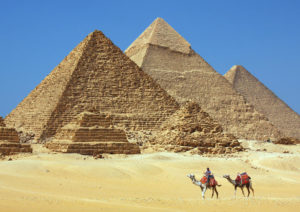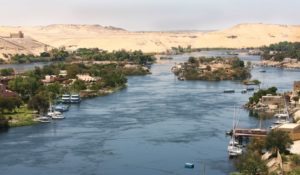
Aslam Shad writes about the glory of the Black Civilisation and how black Africa is the cradle of humanity. Hardly few know that the Land of the Blacks was once a vast band, a big world unto itself.
The Europeans not only distorted and mutilated the history of the Blacks, but also succeeded in conquering the minds of their victims through a series of myths, so much so that even the Africans themselves started believing that they had been/are good for nothing. The myths persistently drilled into the minds of the Blacks over the last more than three centuries are:
. People waiting in darkness for another people to bring the light.
. People without a legitimate God.
. Too primitive and aborigine, having no worthwhile culture or contribution to their credit.
. The Europeans invaders/conquerors being civilisers and a blessing for the Africans.
The aforesaid is not only malicious and one-sided but also totally off the mark. It is now an established fact that humans (Neanderthals, Homo erectus, Homo Floresiensis and Homo Sapiens) first evolved in East Africa 2.5 million years ago, so much so that Black Africa is, in fact, the Cradle of Humanity.
Latest research has revealed that the early Blacks were a great people, excelling on many fronts from a line of builders so distant in the past that it seems to have extended into the Stone Age. It was a society of scientists, scholars, organised religions with organised priesthoods, mathematicians, scribes, architects, engineers, standing armies and generals, stone and brick masons, carpenters, artists, sculptors, cloth makers, farmers, teachers, gold and silversmiths, blacksmiths and so on. Africa as the ‘Cradle of Civilisation’ means exactly that.

Drawing on an impressive level of astronomical knowledge acquired over centuries, the Egyptians were able to create a highly innovative piece of time-keeping equipment, made up of narrow sandstone blocks set up in a small circle some four meters across. The stone circle of Nabta Playa is a far smaller version of Stonehenge (England), but at more than 200 years older, it the world's oldest known calendar, the first to be created by the sun-fixated Egyptians, who, "by their study of astronomy discovered the solar year--their method of calculation was much better than that of the Greeks".
Egypt's first pyramid – Djoser's tomb, a 64 meter high structure of dazzling white limestone that was visible for miles, was built during 32nd dynasty when Djoser was the Pharaoh of Egypt (2667-2648 BC). The man responsible for this stunning job was Imhotep, who in his lifetime was not only a brilliant architect and Prime Minister, but also the high-priest of Heliopolis – now known as Egypt's Leonardo da Vinci.
Responsible for moving nine million tons of stone to create three pyramids, Snefru – the Pharaoh (2613-2589 BC) was himself a larger than life character. He also undertook great boat-building program. The Royal shipyards could produce vessels up to fifty meters long, and the king sent forty such ships to Lebanon to fetch cedar, and to Sinai's Wadi Maghara for turquoise.
Khufu (2589-2566 BC), his successor, built the Great Pyramid of Giza. This death – defying pyramid was constructed from 2300000 blocks of stone, each weighing an average of two and a half tons. Over Khufu's 23-years rule, this required 340 blocks to be moved each ten hour working day, or thirty four blocks per hour, roughly equaling one block every two minutes. With the pyramid's 146 meters height unsurpassed until the construction of Lincoln's Cathedral in England in 1300 AD, it was truly an incredible feat of construction for more than 3800 years which “offered maximum protection for the body buried there".

By the time Alexander the Great was sweeping the civilised world with conquest after conquest, the earliest and greatest Black culture had already flourished and dominated the civilised world for over four centuries and a half.
Thus, at the time when Blacks were leading the civilised world in culture and conquest, East was East, but West was not, and the first European Olympiad was as yet to be held. Rome was nowhere to be seen on the map, and sixteen centuries were to pass before Charlemagne (Emperor of the Roman Empire from 800 to 814 AD) would rule in Europe and Egbert become the first King of England (800- 839 AD). Even then, history was to drag on for another 700 years before the discovery of America.
Memphis founded by Narmer (also called Menes - 3100 BC) remained the capital and one of the greatest cities of ancient Egypt and the world, from the First to the Twentieth Dynasty of Pharaohs (3100-1069 BC) when it yielded to Thebes which previously had remained capital in the Pre-Dynastic Period ( 5300-3100 BC). Just look at what Europe in comparison at that point of time was:
Nowe (Thebes) --Pre-history --Egypt
Memphis---3100 BC --Egypt
Rome (village) --1000 BC- Italy
Rome (town) --250 BC---Italy
Athens (village) --1200 BC--Greece
Athens (city) - 360 BC ---Greece
Antioch ---400 BC --Turkey
Jerusalem ---1400 BC--Palestine
Babylon --2100 BC -- Iraq
The history of ancient Egypt spans the period from the pre-historic settlements of the northern Nile Valley to the Roman conquest in 30 BC. The Pharaonic period is from 3100 BC when Upper and Lower Egypt were unified until the country fell under Macedonian rule in 332 BC. The first Pharaoh of ancient Egypt was Narmer (3100 BC ), while the last ones were Kleopatra and Caesarian -- 30 BC.
The ruler called Pharaoh in ancient Egypt was the political and religious leader of the people and held the titles ‘Lord of the Two Lands’ and ‘High Priest of Every Temple’. The Egyptians firmly believed that the Pharaoh represented the gods on Earth.
Ramses Second ( 1279-1213 BC ) is believed to be Pharaoh in the time of Hazrat Musa ASW . His mummy is on display in the Royal Mummies Chamber of Cairo Museum. He is the one who was drowned in the sea in 1213 BC but his body survived in a mummified form for 3094 years and was discovered in 1881 AD.
River Nile has played the most crucial role in the rise and fall of Black Civilisation in the eastern part of the African Continent. It may be of interest to know that for its 3377 miles through the heart of Black Africa, River Nile sank as it cut deep canyons in its soft limestone floor, leaving cliffs at places from a few hundred to a thousand feet high.
 What this means is that for over three thousand miles through the eastern side of the continent, the Nile was collecting the rich soil which was deposited by it through overflow to enrich 13500 square miles of already fertile soil of the last stretch of 750 miles from Aswan to the sea coast.
What this means is that for over three thousand miles through the eastern side of the continent, the Nile was collecting the rich soil which was deposited by it through overflow to enrich 13500 square miles of already fertile soil of the last stretch of 750 miles from Aswan to the sea coast.
This certainly made Upper Egypt "Bread Basket of the World", but also stirred unending envy of Asia and Europe – the next door neighbors.
So, as long as the Blacks were the sole masters of this fertile chunk of land, as also the Mediterranean and Red Sea coastal belts, their culture dominated everyone and everything around. However, when these lands were snatched from the Blacks by the Hykoks, Libyans, Assyrians, Persians, Macedonians and Romans, they were forced into the interior to concentrate in the already limited survival areas where just to subsist was a daily struggle.
Hardly few know that the Land of the Blacks was once a vast band, a big world unto itself, covering 12000,000 square miles from its northern most point in what is now Tunisil to Cape Aqulhas (Southernmost tip of Africa where the Indian and Atlantic Oceans meet) which is approximately 5000 miles.
The whole of this second largest continent was once Bilad as Sudan, "The Land of the Black”, and not just the southern region to which they had been steadily pushed from the north.
Did the grandeur and glory of Black Civilisation vanish once for all when it was wiped off the face of Upper Egypt or did it bounce back from defeat and decline in some other parts of Africa at a subsequent stage? We will look at this in the second part of the article.
The Europeans not only distorted and mutilated the history of the Blacks, but also succeeded in conquering the minds of their victims through a series of myths, so much so that even the Africans themselves started believing that they had been/are good for nothing. The myths persistently drilled into the minds of the Blacks over the last more than three centuries are:
. People waiting in darkness for another people to bring the light.
. People without a legitimate God.
. Too primitive and aborigine, having no worthwhile culture or contribution to their credit.
. The Europeans invaders/conquerors being civilisers and a blessing for the Africans.
The aforesaid is not only malicious and one-sided but also totally off the mark. It is now an established fact that humans (Neanderthals, Homo erectus, Homo Floresiensis and Homo Sapiens) first evolved in East Africa 2.5 million years ago, so much so that Black Africa is, in fact, the Cradle of Humanity.
Latest research has revealed that the early Blacks were a great people, excelling on many fronts from a line of builders so distant in the past that it seems to have extended into the Stone Age. It was a society of scientists, scholars, organised religions with organised priesthoods, mathematicians, scribes, architects, engineers, standing armies and generals, stone and brick masons, carpenters, artists, sculptors, cloth makers, farmers, teachers, gold and silversmiths, blacksmiths and so on. Africa as the ‘Cradle of Civilisation’ means exactly that.

Drawing on an impressive level of astronomical knowledge acquired over centuries, the Egyptians were able to create a highly innovative piece of time-keeping equipment, made up of narrow sandstone blocks set up in a small circle some four meters across. The stone circle of Nabta Playa is a far smaller version of Stonehenge (England), but at more than 200 years older, it the world's oldest known calendar, the first to be created by the sun-fixated Egyptians, who, "by their study of astronomy discovered the solar year--their method of calculation was much better than that of the Greeks".
Egypt's first pyramid – Djoser's tomb, a 64 meter high structure of dazzling white limestone that was visible for miles, was built during 32nd dynasty when Djoser was the Pharaoh of Egypt (2667-2648 BC). The man responsible for this stunning job was Imhotep, who in his lifetime was not only a brilliant architect and Prime Minister, but also the high-priest of Heliopolis – now known as Egypt's Leonardo da Vinci.
Responsible for moving nine million tons of stone to create three pyramids, Snefru – the Pharaoh (2613-2589 BC) was himself a larger than life character. He also undertook great boat-building program. The Royal shipyards could produce vessels up to fifty meters long, and the king sent forty such ships to Lebanon to fetch cedar, and to Sinai's Wadi Maghara for turquoise.
Khufu (2589-2566 BC), his successor, built the Great Pyramid of Giza. This death – defying pyramid was constructed from 2300000 blocks of stone, each weighing an average of two and a half tons. Over Khufu's 23-years rule, this required 340 blocks to be moved each ten hour working day, or thirty four blocks per hour, roughly equaling one block every two minutes. With the pyramid's 146 meters height unsurpassed until the construction of Lincoln's Cathedral in England in 1300 AD, it was truly an incredible feat of construction for more than 3800 years which “offered maximum protection for the body buried there".

By the time Alexander the Great was sweeping the civilised world with conquest after conquest, the earliest and greatest Black culture had already flourished and dominated the civilised world for over four centuries and a half.
Thus, at the time when Blacks were leading the civilised world in culture and conquest, East was East, but West was not, and the first European Olympiad was as yet to be held. Rome was nowhere to be seen on the map, and sixteen centuries were to pass before Charlemagne (Emperor of the Roman Empire from 800 to 814 AD) would rule in Europe and Egbert become the first King of England (800- 839 AD). Even then, history was to drag on for another 700 years before the discovery of America.
Memphis founded by Narmer (also called Menes - 3100 BC) remained the capital and one of the greatest cities of ancient Egypt and the world, from the First to the Twentieth Dynasty of Pharaohs (3100-1069 BC) when it yielded to Thebes which previously had remained capital in the Pre-Dynastic Period ( 5300-3100 BC). Just look at what Europe in comparison at that point of time was:
Nowe (Thebes) --Pre-history --Egypt
Memphis---3100 BC --Egypt
Rome (village) --1000 BC- Italy
Rome (town) --250 BC---Italy
Athens (village) --1200 BC--Greece
Athens (city) - 360 BC ---Greece
Antioch ---400 BC --Turkey
Jerusalem ---1400 BC--Palestine
Babylon --2100 BC -- Iraq
The history of ancient Egypt spans the period from the pre-historic settlements of the northern Nile Valley to the Roman conquest in 30 BC. The Pharaonic period is from 3100 BC when Upper and Lower Egypt were unified until the country fell under Macedonian rule in 332 BC. The first Pharaoh of ancient Egypt was Narmer (3100 BC ), while the last ones were Kleopatra and Caesarian -- 30 BC.
The ruler called Pharaoh in ancient Egypt was the political and religious leader of the people and held the titles ‘Lord of the Two Lands’ and ‘High Priest of Every Temple’. The Egyptians firmly believed that the Pharaoh represented the gods on Earth.
Ramses Second ( 1279-1213 BC ) is believed to be Pharaoh in the time of Hazrat Musa ASW . His mummy is on display in the Royal Mummies Chamber of Cairo Museum. He is the one who was drowned in the sea in 1213 BC but his body survived in a mummified form for 3094 years and was discovered in 1881 AD.
River Nile has played the most crucial role in the rise and fall of Black Civilisation in the eastern part of the African Continent. It may be of interest to know that for its 3377 miles through the heart of Black Africa, River Nile sank as it cut deep canyons in its soft limestone floor, leaving cliffs at places from a few hundred to a thousand feet high.
 What this means is that for over three thousand miles through the eastern side of the continent, the Nile was collecting the rich soil which was deposited by it through overflow to enrich 13500 square miles of already fertile soil of the last stretch of 750 miles from Aswan to the sea coast.
What this means is that for over three thousand miles through the eastern side of the continent, the Nile was collecting the rich soil which was deposited by it through overflow to enrich 13500 square miles of already fertile soil of the last stretch of 750 miles from Aswan to the sea coast.This certainly made Upper Egypt "Bread Basket of the World", but also stirred unending envy of Asia and Europe – the next door neighbors.
So, as long as the Blacks were the sole masters of this fertile chunk of land, as also the Mediterranean and Red Sea coastal belts, their culture dominated everyone and everything around. However, when these lands were snatched from the Blacks by the Hykoks, Libyans, Assyrians, Persians, Macedonians and Romans, they were forced into the interior to concentrate in the already limited survival areas where just to subsist was a daily struggle.
Hardly few know that the Land of the Blacks was once a vast band, a big world unto itself, covering 12000,000 square miles from its northern most point in what is now Tunisil to Cape Aqulhas (Southernmost tip of Africa where the Indian and Atlantic Oceans meet) which is approximately 5000 miles.
The whole of this second largest continent was once Bilad as Sudan, "The Land of the Black”, and not just the southern region to which they had been steadily pushed from the north.
Did the grandeur and glory of Black Civilisation vanish once for all when it was wiped off the face of Upper Egypt or did it bounce back from defeat and decline in some other parts of Africa at a subsequent stage? We will look at this in the second part of the article.
